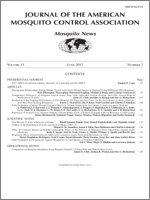Attractive toxic sugar bait (ATSB) was applied to 5 different types of commonly found plants in landscaping of northeastern Florida. The ATSB applications were assessed for possible plant effects and preference against Aedes albopictus in semifield evaluations. Positive and negative controls consisted of plants sprayed with attractive sugar bait (no toxicant) and plants with nothing applied. Bioassays were conducted on stems with leaf clippings and on full plants to assess any difference in mosquito mortality on the different plants. Plants utilized in these evaluations were Indian hawthorne, Yaupon holly, Japanese privet, Loropetalum ruby, and podocarpus. In both assays, no significant difference was observed in the effect of ATSBs on adult female mosquitoes based on the type of plant. ATSB could be applied to common landscape plants for adult Ae. albopictus control.
How to translate text using browser tools
1 June 2017
Effect of Common Species of Florida Landscaping Plants on the Efficacy of Attractive Toxic Sugar Baits Against Aedes albopictus
Kelly E. Seeger,
Jodi M. Scott,
Gunter C. Muller,
Whitney A. Qualls,
Rui-De Xue
ACCESS THE FULL ARTICLE
It is not available for individual sale.
This article is only available to subscribers.
It is not available for individual sale.
It is not available for individual sale.
Aedes albopictus
ATSB
boric acid
landscape plants





